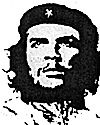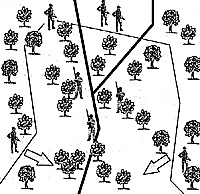 I knew you were going to shoot me; I should never have been taken alive.
I knew you were going to shoot me; I should never have been taken alive.
"The guerrilla fighter needs full help from the people of the area. This is an indispensable condition. This is clearly seen by considering the case of bandit gangs that operate in a region. They have all the characteristics of a guerrilla army : homogeneity, respect for the leader, valor, knowledge of he ground, and, often, even good understanding of the tactics to be employed. The only thing missing is support of the people; and, inevitably, these gangs are captured and exterminated by the public force"
Che Guevara
Possibly the most chic revolutionary ever to wear a beret and shades, was Che Ernesto Guevara.
His portrait in revolutionary red and black hung from a million bedroom walls throughout the late sixties and early seventies - and even inspired a British sitcom - who (of my age at least) can forget "Wolfie" and the Tooting Popular Front?
This year marks the 30th anniversary of Che Guevara`s death. There is a cynical irony that his image now generates plenty of the dollar he despised so much. Expect a rush of books, films and documentaries. Indeed this scenario was prompted by October`s issue of Esquire Magazine - a damn good read by the way.
Final Crusade
In 1966 Che Guevara embarked on his final revolutionary crusade. His plan was to rally the communists and peasants of Bolivia into a guerrilla movement which would tumble the peacock military dictatorships of Latin America like dominoes. But Che's final revolutionary adventure was grossly misjudged, totally overestimating the revolutionary potential of the native Andes Indians. His miscalculation, ignoring his own military dictum would have disastrous consequences.
Without the support of the populous upon which they depended, Che`s revolutionaries were relegated to living solely off revolutionary ideals. His increasingly bedraggled band of 'freedom fighters' found itself faced with indifference from the peasantry, disdain from the middle class communists, and determined opposition from the Bolivian government forces.
During the night of October 7th, 1967, spirits were low. As the party of armed men moved along a barranco at the bottom of the Churo Gorge, a potato farmer spotted them. Without hesitating, the farmer had his son run to alert the army outpost of the Eighth Bolivian Division under Captain Gary Prado, around a mile or so away.
Upon hearing the news, Prado swung into action and moved his platoon (?) into what has been described as a "textbook ambush". Placing his command post on commanding ground, Prado posted his men to cover the head of the gorge, whilst further troops were despatched to block the guerrillas exit.
Guevara, perhaps sensing trouble, had split his small command into smaller squads which were felling their own way forward through the vegetation, looking for a way out. It was too late. As the sun rose above the lip of the gorge they spotted the army positions.
Che ordered his men to fall back in the hope that the army hadn`t already sealed the entrance trapping them like insects in a bottle.
Around 1.30pm on the 8th of October the lead guerrilla detachment came under fire ; the guerrilla squads went to ground, isolated from each other, they could only wait to be picked off piecemeal.
Che ordered his squad of seven guerrillas to retire back into the ravine which dominated the gorge, as they were unable to match the volume of fire directed at them. Within minutes the squad had been cut to pieces and Che with a bullet wound to his calf was being half-dragged to safety by his loyal lieutenant Willi Cuba.
Two Bolivian soldiers burst from the bush. Che had lost his M1 carbine and had used up all his pistol clips, but Willi still had his sub-machine gun. The soldiers raised their weapons but seemed hesitant. Willi, encumbered by the wounded Guevara decided the moment. He threw down his weapon and shouted "Shit, this is Commander Guevara". An act which probably saved both their lives. Though unfortunately not for long.
Prado was exulted. He marched the wounded Guevara two kilometres back to the hamlet of La Higuera. The march took a comic opera turn as Prado and his captive Guevara, were followed by the other prisoners, mules carrying the bodies of the slain, wounded soldiers and finally a colourful column of hundreds of onlookers.
Bolivian government was in a fix over what to do with their captive. What sort of international outcry would there be for his release ? Would Cuban commandos attempt to free him in a daring raid? By mid-morning of the 9th October, the decision had been made. The job fell to Lieutenant Mario Terán and Che Guevara, was executed in the school at La Higuera where he had been imprisoned the night before. Passing into legend as the heroic symbol of Sixties rebellion and idealism.
Compañero : The Life and Death of Che Guevara by Jorge G Castaneda (Bloomsbury £ 20)
GUERRILLAS IN THE MIST
The military history of Latin America has been largely overlooked by wargames figure manufacturers, despite the best efforts of the excellent journal El Dorado. This is particularly true of the C20th. So, as I write, there are no dedicated figures available to my knowledge for this interesting little encounter. However! A little bit of ingenuity courtesy of Mr. Pig`s finest will see us through.
Photos of the Bolivian troops show them in Olive Greens (?) with peaked fatigue caps, US weaponry and webbing, though I have seen some photos of the Bolivians in USMC style jungle camo. So in a crisis I thought WW2 guys with rifles / carbines / BARS, and well they probably had US M1 helmets back at the barracks. Otherwise it would some of the new Modern African figures in caps, but for me at least, the weapons would look all wrong. Bolivian Officers wore a very Germanic uniform - Prado may have worn a beret or cap but I chose a more noble figure for him from the Peter Pig SCW Republican Senior Officer pack. As an aside, it`s actually not too difficult to carve the helmet down into a peaked cap given the metal Martin uses - but hey, let`s play the game and see if we like it first.
Che`s band wore all sorts, mainly OG again I suspect with a few camo items thrown in. No helmets, just berets and caps and the occasional jungle hat. Martin Goddard`s Spanish Civil War types came to the rescue here, as many of the figures look suitably rebellish. The figures in beret and peaked cap (suitably trimmed) from the International Brigade pack provided most of the types I wanted. Che came from the Militia pack, there`s a lovely figure with what looks like a tommy gun and raised fist - little use as a Spanish militiaman I always felt, but his hour had come - sidecap turned into beret and some cool shades from flattened discs of Milliput. You couldn`t ask for a finer revolutionary leader - until someone produces one that is.
 Using R.A.S.H. from page 36, Prado and his men count as Trained. Prado leads a four man command group with a Light Machine-Gun and three 12 man squads (to simplify matters the squad leader has an M1 Carbine and his men M1 Rifles). The 17 Revolutionaries are divided into 3 squads. Each squad has one Thompson SMG, one M1 Carbine and the rest M1 Rifles. They count as Rabble for firing but Trained for all morale purposes.
Using R.A.S.H. from page 36, Prado and his men count as Trained. Prado leads a four man command group with a Light Machine-Gun and three 12 man squads (to simplify matters the squad leader has an M1 Carbine and his men M1 Rifles). The 17 Revolutionaries are divided into 3 squads. Each squad has one Thompson SMG, one M1 Carbine and the rest M1 Rifles. They count as Rabble for firing but Trained for all morale purposes.
Back to The Gauntlet No. 10 Table of Contents
Back to The Gauntlet List of Issues
Back to Master Magazine List
© Copyright 1997 by Craig Martelle Publications
This article appears in MagWeb (Magazine Web) on the Internet World Wide Web.
Other military history articles and gaming articles are available at http://www.magweb.com